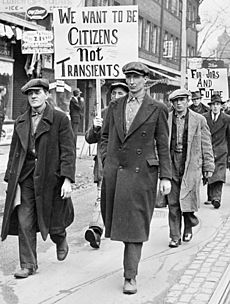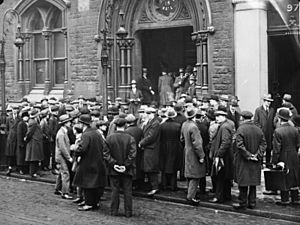Great Depression facts for kids
The Great Depression was a huge worldwide economic crisis that began after the U.S. stock market crash in 1929. Prices on the Wall Street stock market fell a lot from October 24 to October 29, 1929. Many people lost their jobs. By 1932, about 25–30% of people were unemployed. They became homeless and poor. This time ended the wealth of the Roaring Twenties. Many people think the Great Depression started on Tuesday, October 29. However, economists believe Black Tuesday was just one of the reasons it happened.
From 1929 to 1932, the depression got worse. Some people think that higher taxes on American citizens and increased tariffs (taxes on goods from other countries) made it worse. Economist Milton Friedman said the Great Depression became worse because the Federal Reserve printed less money than usual.
When the Great Depression started, Herbert Hoover was the president of the United States. He was often blamed for the crisis. In 1932, people voted for a new president, Franklin D. Roosevelt. Roosevelt created many new laws and programs to help those affected by the Great Depression. These programs were known as the New Deal.
One program was the Civilian Conservation Corps, or CCC. The CCC gave young men jobs working outdoors. They earned thirty dollars a month, and twenty-five dollars was sent home to their families. They also received free food and shelter. Another important program was Social Security. Social Security gave older people a small income so they had money for their needs. The Great Depression was very tough, but with everyone's effort, things slowly improved. Between 1939 and 1944, more people found jobs because of World War II, and the Great Depression finally ended.
Contents
What Caused the Great Depression?
One important reason for the Great Depression was the Treaty of Versailles. This treaty made the United States very rich after World War I. Britain and France owed a lot of money to the U.S. Also, Germany had to pay a huge amount for the damage caused in the war. However, this sudden wealth helped lead to the stock market crash.
Even after the Wall Street Crash of 1929, people still had hope. John D. Rockefeller said, "These are days when many are discouraged. In the 93 years of my life, depressions have come and gone. Prosperity (wealth) has always returned (come back) and will again." But soon, the bad effects of the depression grew worse. People lost jobs, money, and homes. There were reports of great hunger, disease, and even starvation in Germany and the United States. Countries started using protectionism more, which meant less international trade.
The Dust Bowl Disaster

Farmers usually avoided the worst effects of earlier depressions because they could at least grow their own food. But during the Great Depression, the Great Plains region was also hit hard by a terrible drought and huge dust storms. This period was called the Dust Bowl.
Years of overgrazing (too many animals eating the grass) combined with the drought caused the grass to disappear. With the topsoil (the rich upper layer of soil) exposed, strong winds picked up the loose dirt. These dust storms carried the dirt over long distances. The storms destroyed crops, leaving farmers with no food or anything to sell.
Small farmers faced the toughest times. Even before the dust storms, the invention of the tractor greatly reduced the need for workers on farms. These small farmers were often already in debt. They borrowed money for seeds and planned to pay it back when their crops grew. When the dust storms ruined their crops, they couldn't feed their families or pay back their debts. Banks would then take their farms, leaving the families homeless, jobless, and poor.
How the Depression Affected Countries
Most countries started programs to help their people. Many also saw big political changes, often leading to more strict governments. In Europe and Latin America, many democracies were replaced by dictatorships. A famous example is Germany in 1933.
Australia's Struggles
Australia relied heavily on selling farm products and industrial goods to other countries. This made it one of the hardest-hit developed nations. When demand for its exports fell, wages dropped a lot. Unemployment reached a record high of 29% in 1932. There were often protests and unrest. After 1932, prices for wool and meat went up, leading to a slow recovery.
Canada's Economic Downturn
Canada was badly affected by both the global economic crisis and the Dust Bowl. By 1932, Canadian factory production had dropped to only 58% of its 1929 level. This was the second lowest in the world, after the United States. Canada's total national income fell to 56% of its 1929 level. Unemployment reached 27% in 1933, the worst point of the Depression.
Germany's Hardship
The Great Depression hit Germany very hard. The Wall Street Crash meant American banks stopped giving new loans. These loans had been helping Germany pay back its war debts under the Dawes Plan and the Young Plan. The money crisis got out of control. In mid-1931, a bank in Vienna collapsed, putting more pressure on Germany. Germany was already facing political problems at this time.
The Soviet Union's Unique Situation
The Soviet Union was the world's only communist state at the time. It had very little international trade. Because its economy was not closely connected to the rest of the world, it was only slightly affected by the Great Depression. During the Depression, the Soviet economy was actually growing steadily. This growth was fueled by heavy investment in large industries. The Great Depression even caused many people to move to the Soviet Union, mostly from Finland and Germany.
United Kingdom's Challenges
The global depression hit the United Kingdom when it was still recovering from World War I. The country had to stop using the gold standard in 1931. The effects on the northern industrial areas of Britain were immediate and terrible. Demand for traditional factory products collapsed. By the end of 1930, unemployment had more than doubled from 1 million to 2.5 million people. Exports had also fallen by 50%. In 1933, 30% of people in Glasgow were unemployed. This was due to the huge decline in heavy industries like shipbuilding. In some northern towns, unemployment reached as high as 70%.
However, in the less industrial Midlands and Southern England, the effects were not as long-lasting. The later 1930s were a good time for these areas. New factories making electrical goods and a boom in the car industry helped. This was supported by a growing population in the south and a rising middle class. Farming also did well during this period.
Related Pages
Images for kids
-
Money supply decreased considerably between Black Tuesday and the Bank Holiday in March 1933 when there were massive bank runs across the United States.
-
Crowd gathering at the intersection of Wall Street and Broad Street after the 1929 crash.
-
The Great Depression in the U.S. from a monetary view. Real gross domestic product in 1996-Dollar (blue), price index (red), money supply M2 (green) and number of banks (grey). All data adjusted to 1929 = 100%.
-
Crowds outside the Bank of United States in New York after its failure in 1931.
-
Power farming displaces tenants from the land in the western dry cotton area. Childress County, Texas, 1938.
-
A female factory worker in 1942, Fort Worth, Texas. Women entered the workforce as men were drafted into the armed forces.
-
Adolf Hitler speaking in 1935.
-
Benito Mussolini giving a speech at the Fiat Lingotto factory in Turin, 1932.
-
Burning shacks on the Anacostia flats, Washington, D.C. put up by the Bonus Army (World War I veterans) after the marchers with their wives and children were driven out by the regular Army by order of President Hoover, 1932.
-
Buried machinery in a barn lot; South Dakota, May 1936. The Dust Bowl on the Great Plains coincided with the Great Depression.
-
The WPA employed 2–3 million at unskilled labor.
-
Black Friday, May 9, 1873, Vienna Stock Exchange. The Panic of 1873 and Long Depression followed.
See also
 In Spanish: Gran Depresión para niños
In Spanish: Gran Depresión para niños


















